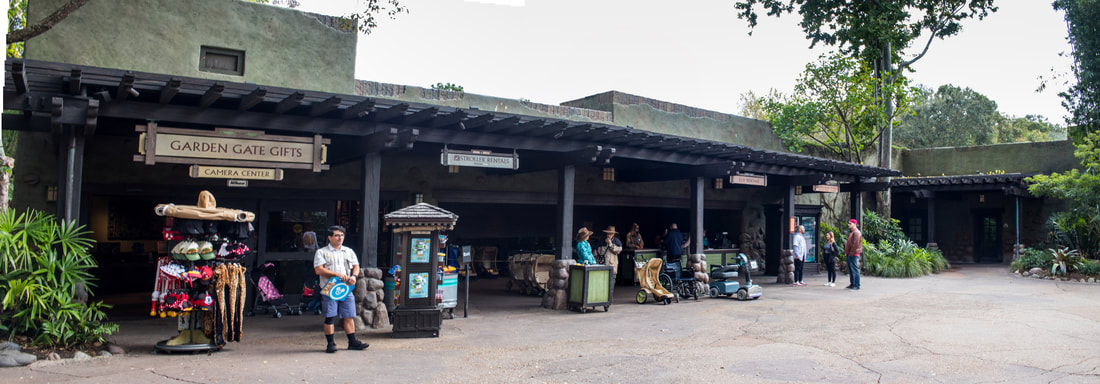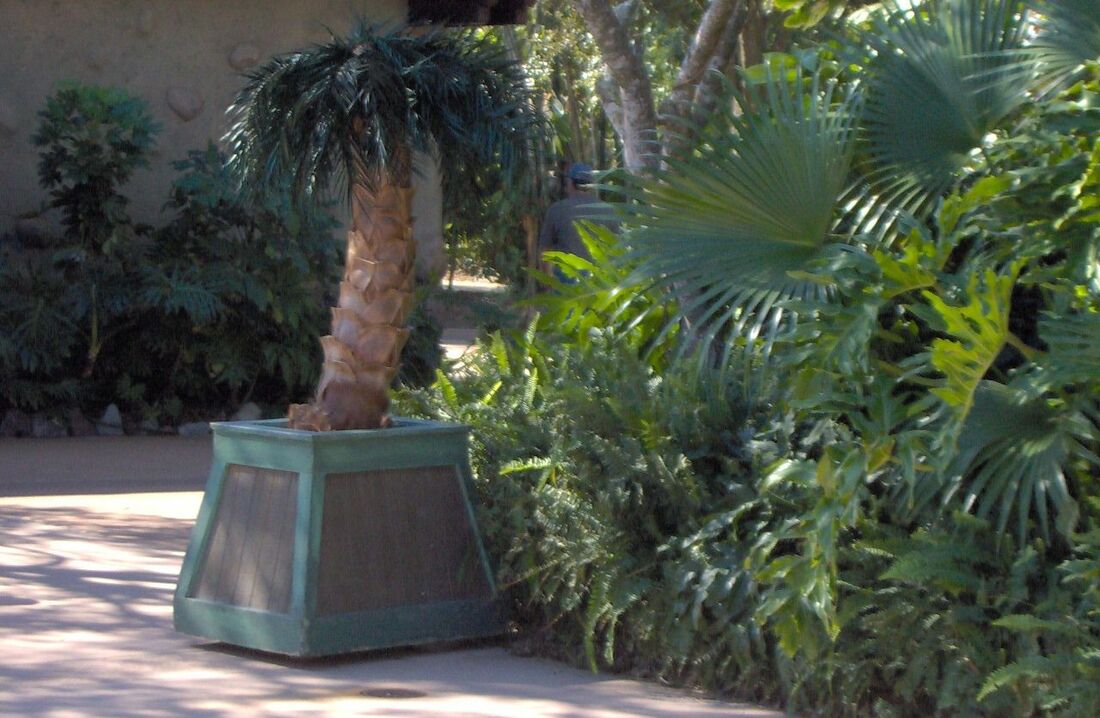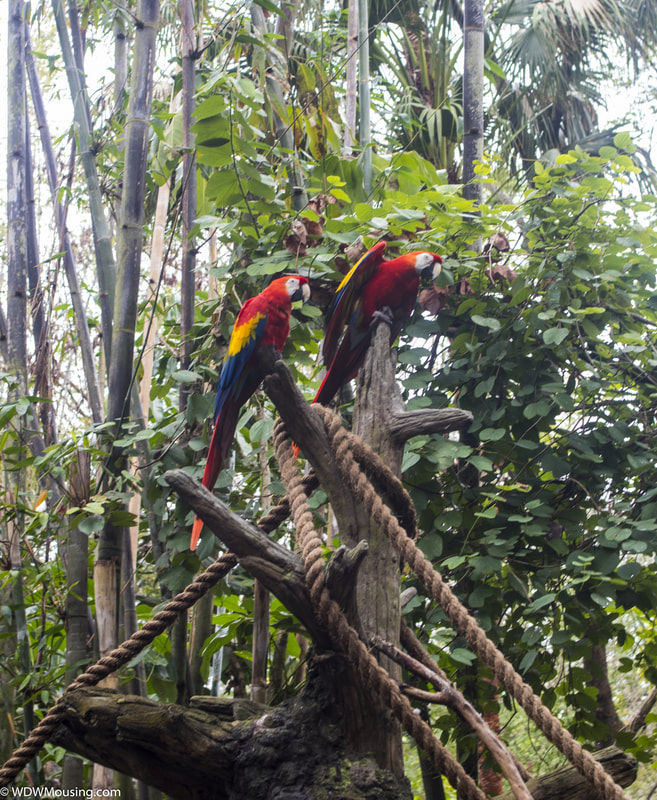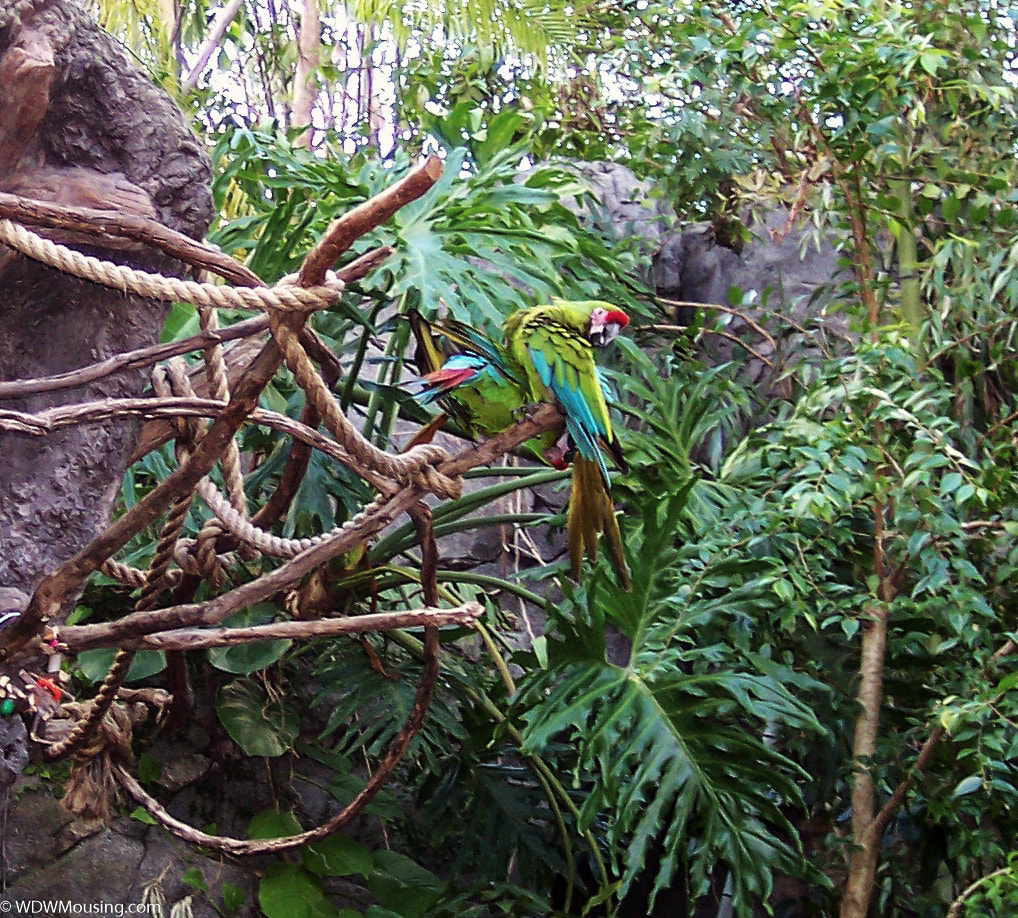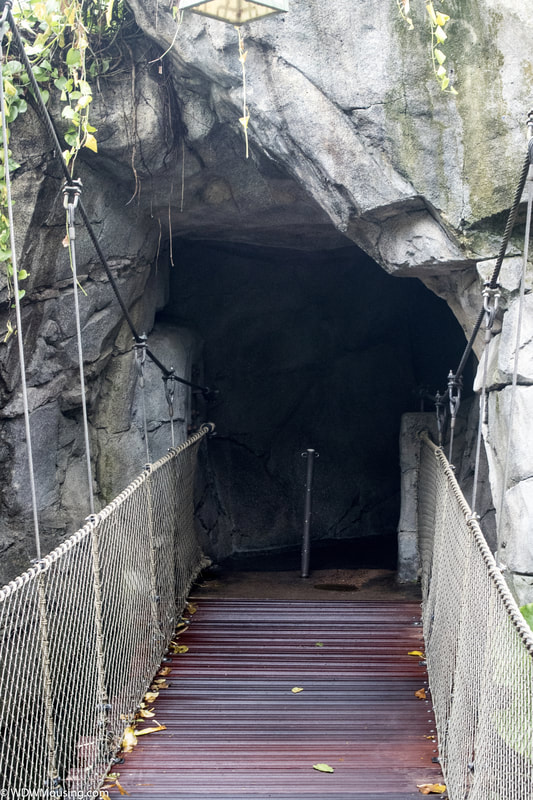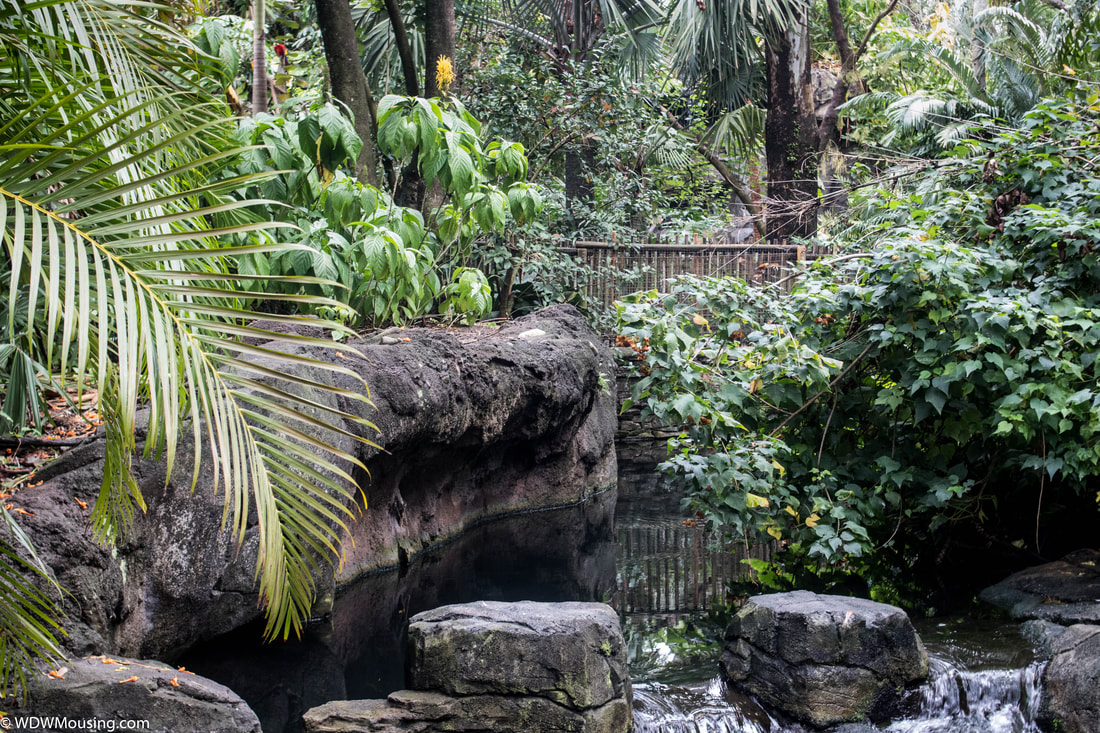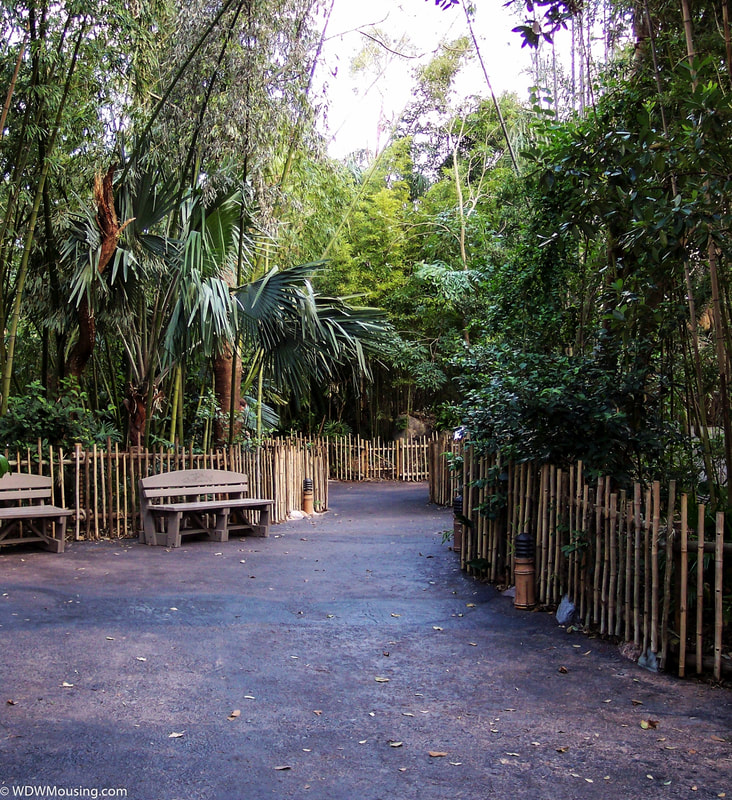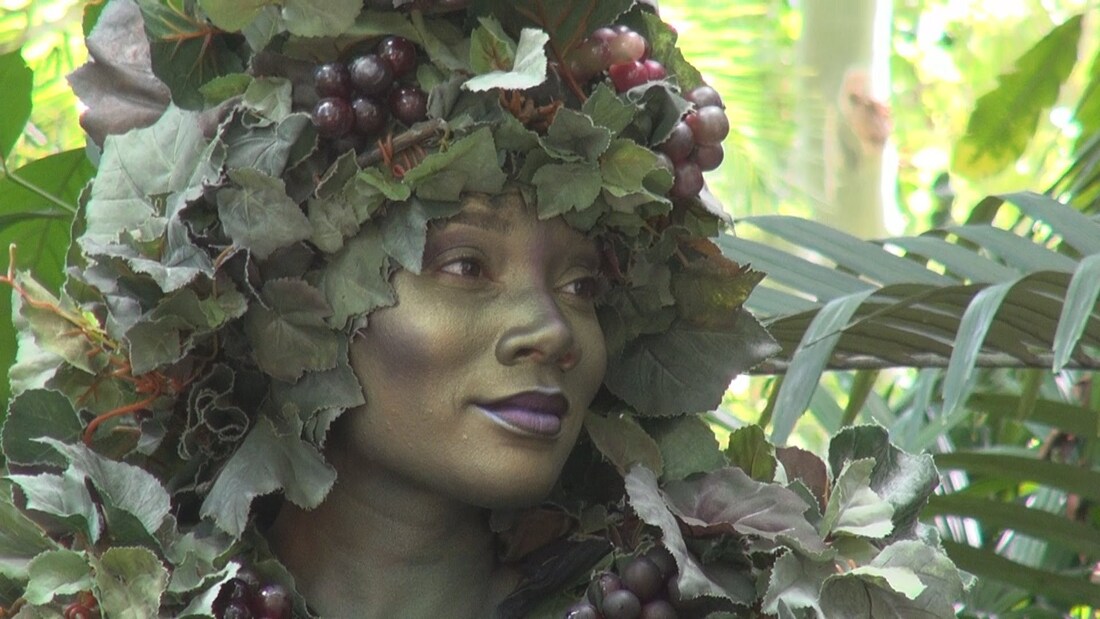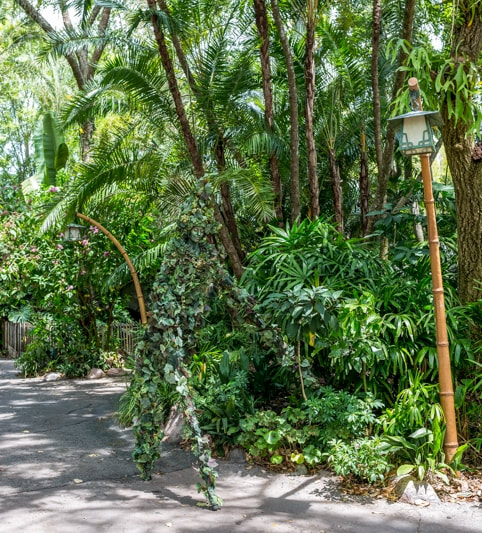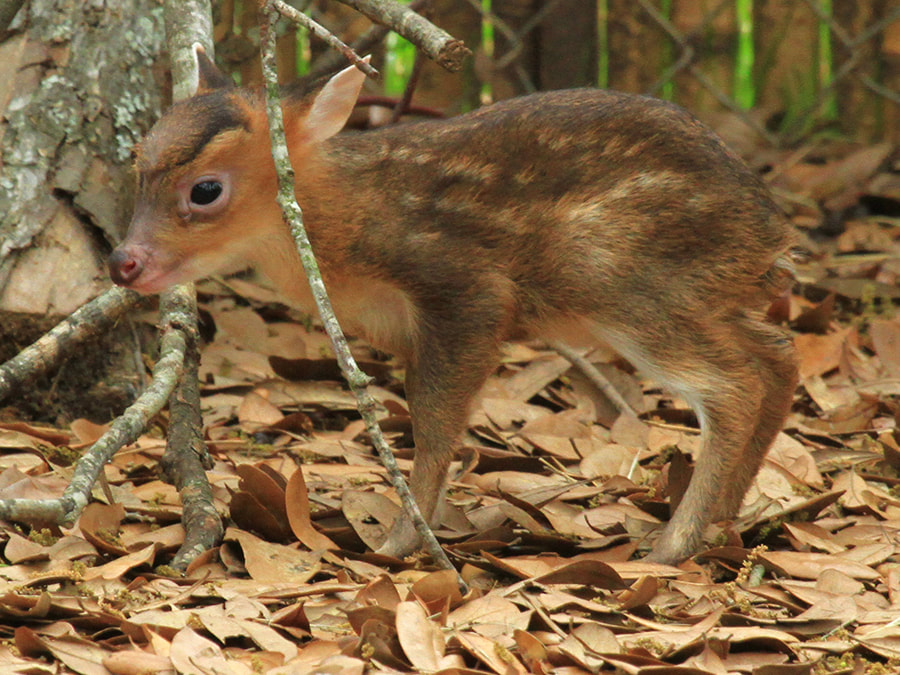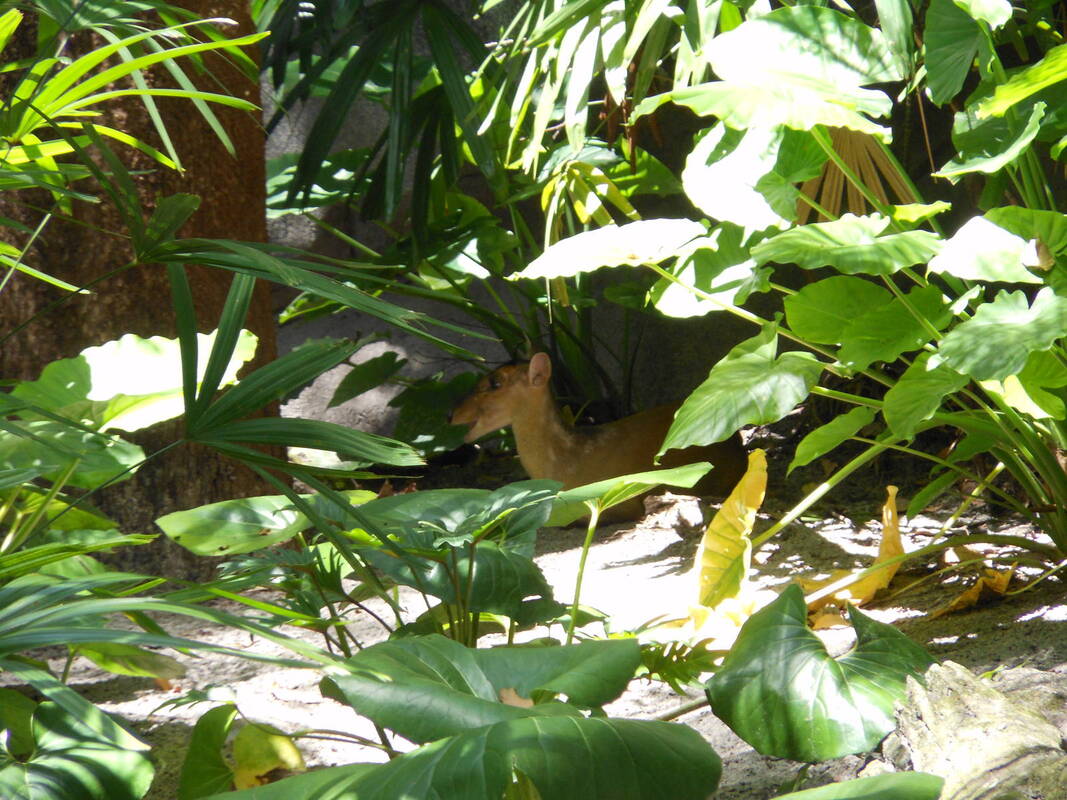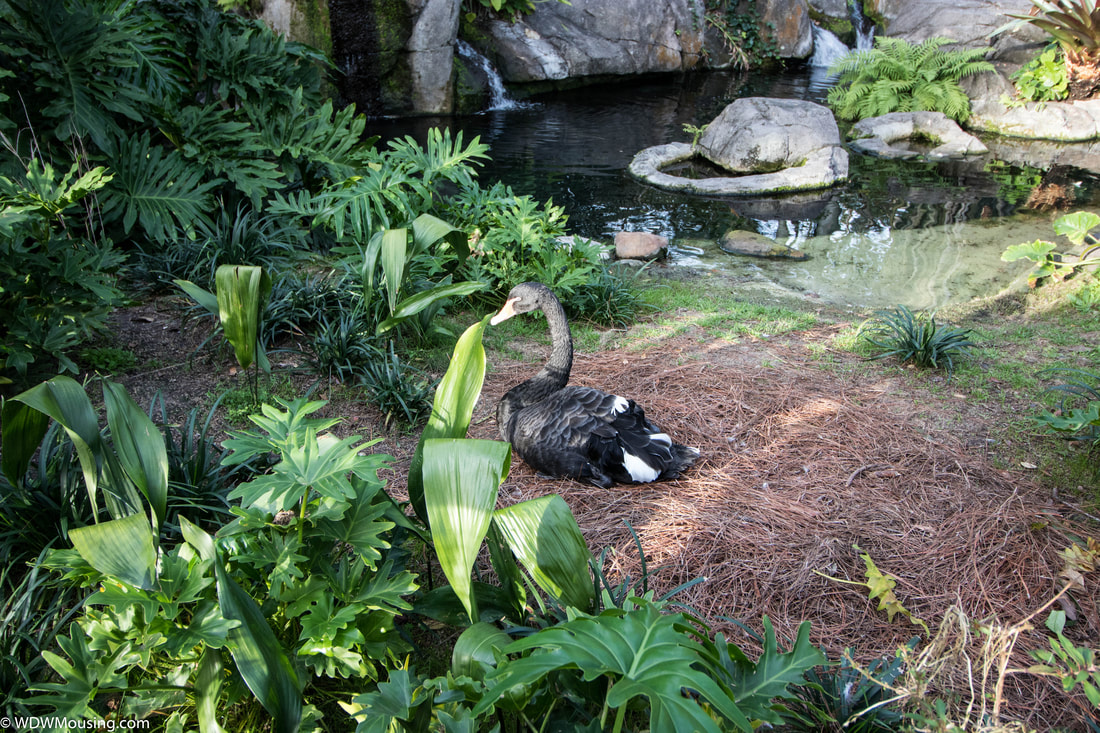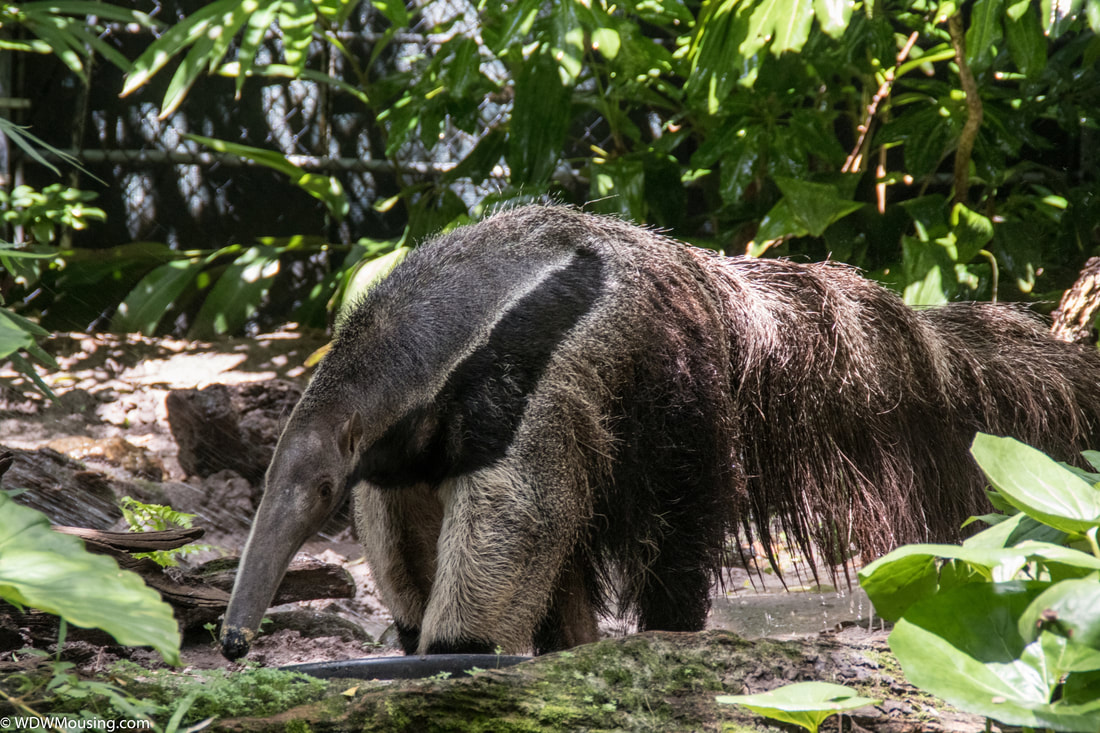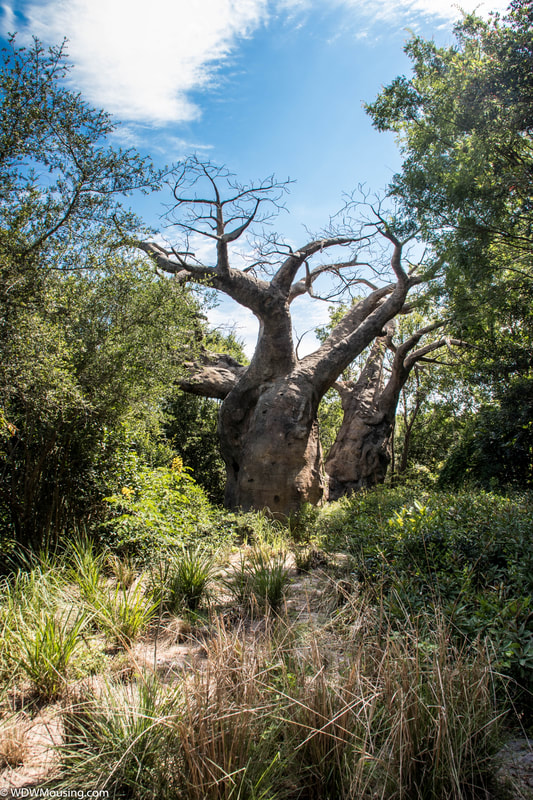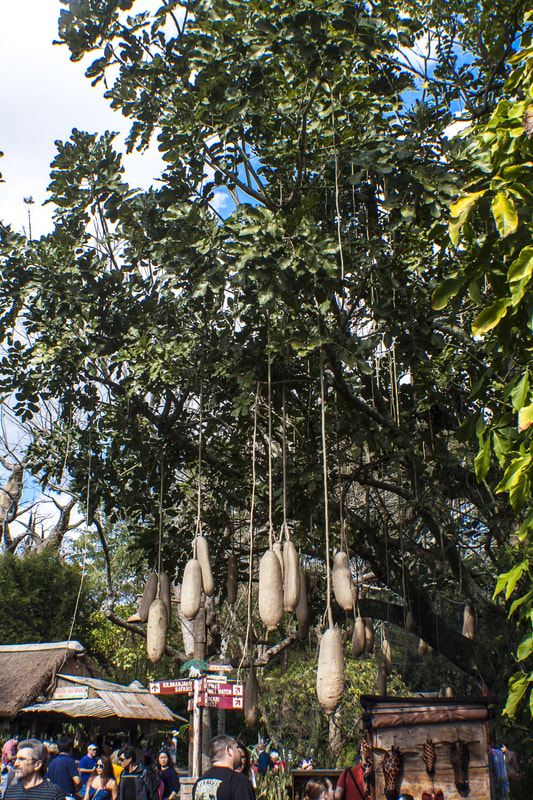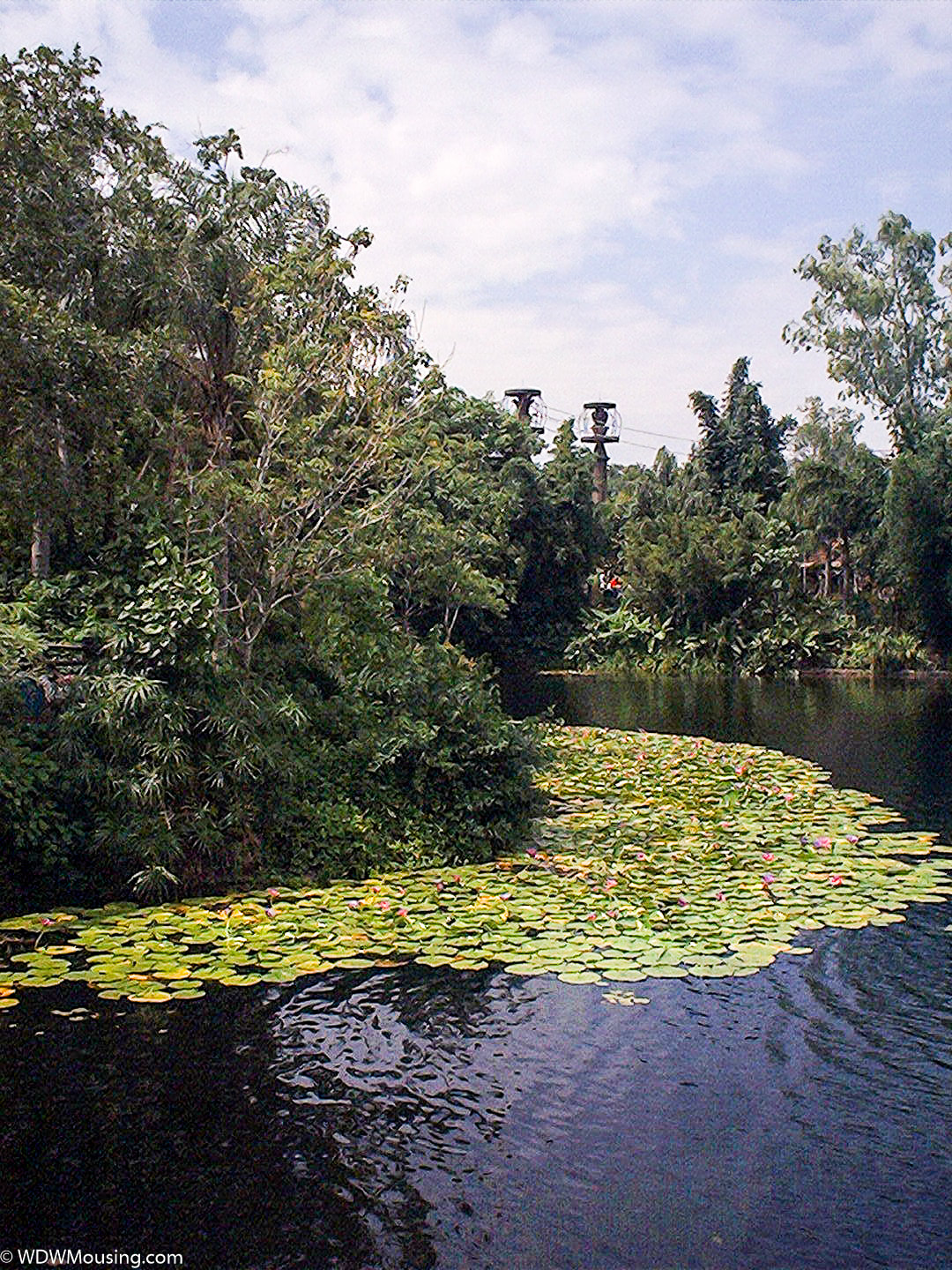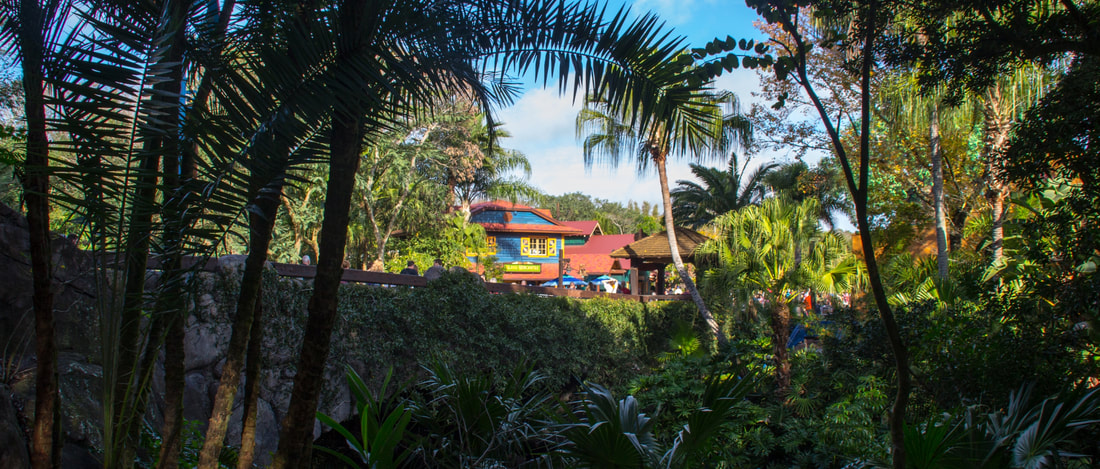Chapter 2 - Animal Kingdom - The Oasis posted Jan 2021
|
For current map of Animal Kingdom: |
The Oasis is the first land guests pass through after entering the Animal Kingdom.
The Oasis provides guests with a shady and lush passageway and transition from the outside world to the rest of Animal Kingdom. it has a series of winding paths that make up The Oasis Exhibits. These exhibits are a collection of different animals and foliage that are meant to be explored before walking over the bridge to Discovery Island.
Many guests rush through this area, because there are no major attractions, assuming there is nothing worth seeing. But the Oasis is a destination unto itself. It’s a beautiful, serene area full of jungle foliage and amazing animal exhibits.
The Oasis Exhibits is a walkthrough exhibit attraction. The Oasis was designed to put guests into contact with animals immediately upon entering the park. It features animals such as scarlet macaws, muntjacs, spoonbills, and giant anteaters. Freshwater fish native to Florida such as Florida and Longnose gar inhabit the waters of the exhibits.
The Oasis Exhibits and all of the amazing creatures and plant life in the area were part of the opening day experience for Disney’s Animal Kingdom.The park made its official opening on April 22, 1998, which was also Earth Day.
The Oasis provides guests with a shady and lush passageway and transition from the outside world to the rest of Animal Kingdom. it has a series of winding paths that make up The Oasis Exhibits. These exhibits are a collection of different animals and foliage that are meant to be explored before walking over the bridge to Discovery Island.
Many guests rush through this area, because there are no major attractions, assuming there is nothing worth seeing. But the Oasis is a destination unto itself. It’s a beautiful, serene area full of jungle foliage and amazing animal exhibits.
The Oasis Exhibits is a walkthrough exhibit attraction. The Oasis was designed to put guests into contact with animals immediately upon entering the park. It features animals such as scarlet macaws, muntjacs, spoonbills, and giant anteaters. Freshwater fish native to Florida such as Florida and Longnose gar inhabit the waters of the exhibits.
The Oasis Exhibits and all of the amazing creatures and plant life in the area were part of the opening day experience for Disney’s Animal Kingdom.The park made its official opening on April 22, 1998, which was also Earth Day.
|
Let's proceed through The Oasis with some soothing music. |
Garden Gate Gifts
As guests enter the park, to the right is the Garden Gate Gift shop where they can pick up anything they may need to the day in the park – or can stop for a last-minute souvenir on the way out! The Garden Gate Gifts has photo albums and camera paraphernalia, gifts, and sweets and snacks. Next to the shop guests can rent wheelchairs, EVC and strollers.
Source:
https://www.couponingtodisney.com/garden-gate-gifts-animal-kingdom/
As guests enter the park, to the right is the Garden Gate Gift shop where they can pick up anything they may need to the day in the park – or can stop for a last-minute souvenir on the way out! The Garden Gate Gifts has photo albums and camera paraphernalia, gifts, and sweets and snacks. Next to the shop guests can rent wheelchairs, EVC and strollers.
Source:
https://www.couponingtodisney.com/garden-gate-gifts-animal-kingdom/
Guest Services
To the left of the entrance is the Guest Services. If guests have questions, or would like to view their PhotoPass photos, or if need to speak to a guest services cast member, the Oasis is where they’ll want to go. It’s also where guests will be able to picking up any packages that they may have had shipped to the front of the park during their visit. (But remember that guests staying at Disney resorts are also eligible to ship purchases back to their resort gift shop as well, free of charge).
Resource:
http://madaboutthemouse.net/parks/disneys-animal-kingdom-theme-park/animal-kingdom-guest-services/
To the left of the entrance is the Guest Services. If guests have questions, or would like to view their PhotoPass photos, or if need to speak to a guest services cast member, the Oasis is where they’ll want to go. It’s also where guests will be able to picking up any packages that they may have had shipped to the front of the park during their visit. (But remember that guests staying at Disney resorts are also eligible to ship purchases back to their resort gift shop as well, free of charge).
Resource:
http://madaboutthemouse.net/parks/disneys-animal-kingdom-theme-park/animal-kingdom-guest-services/

Rainforest Café
Animal Kingdom Rainforest has a double entrance – one outside the park and one inside the park. The Rainforest Café entrance is located where the Oasis begins.
The Rainforest Café has an immense amount of details. Every nook and cranny holds something that pertains to the Rainforest.
Guests will eat amid a tropical jungle complete with animatronic animals, whose movements and sounds will make you feel like you’re deep in the rainforest. There’s a monkey swinging on a vine, a baby elephant with its mom, giant flapping butterflies, and even a crocodile. And regularly scheduled thunderstorms! It even has an enormous aquarium full of beautifully colored tropical fish, of course, as well as the gift shop on site. The restaurant gift shop has unique selection. Rainforest t-shirts and gear are available, as well as, drums, home décor, even jewelry with jungle themes. If you are an animal lover this is a great shop to visit even if you don’t eat at Rainforest Café.
Guests can book your dining expedition at Rainforest Café for breakfast, lunch or dinner.
Latest Menu:
Rainforest Cafe® at Disney's Animal Kingdom Menu | Walt Disney World Resort (go.com)
Reference:
https://www.disneylists.com/2016/04/7-things-know-rainforest-cafe-disney-world/?utm_source=DisneyList.com+Update&utm_campaign=403a43b209-DisneyLists_com_Update_2_9_19&utm_medium=email&utm_term=0_e09735652c-403a43b209-283624153
Animal Kingdom Rainforest has a double entrance – one outside the park and one inside the park. The Rainforest Café entrance is located where the Oasis begins.
The Rainforest Café has an immense amount of details. Every nook and cranny holds something that pertains to the Rainforest.
Guests will eat amid a tropical jungle complete with animatronic animals, whose movements and sounds will make you feel like you’re deep in the rainforest. There’s a monkey swinging on a vine, a baby elephant with its mom, giant flapping butterflies, and even a crocodile. And regularly scheduled thunderstorms! It even has an enormous aquarium full of beautifully colored tropical fish, of course, as well as the gift shop on site. The restaurant gift shop has unique selection. Rainforest t-shirts and gear are available, as well as, drums, home décor, even jewelry with jungle themes. If you are an animal lover this is a great shop to visit even if you don’t eat at Rainforest Café.
Guests can book your dining expedition at Rainforest Café for breakfast, lunch or dinner.
Latest Menu:
Rainforest Cafe® at Disney's Animal Kingdom Menu | Walt Disney World Resort (go.com)
Reference:
https://www.disneylists.com/2016/04/7-things-know-rainforest-cafe-disney-world/?utm_source=DisneyList.com+Update&utm_campaign=403a43b209-DisneyLists_com_Update_2_9_19&utm_medium=email&utm_term=0_e09735652c-403a43b209-283624153
Since the Oasis is located between the Park entrance and the shops on Discovery Island, this area is never crowded. That isn’t to say that there is nothing to see here though. If guests are looking to escape the crowds or just take their time enjoying nature on the way in or out of the park, the Oasis is the perfect hideaway to slow it down and take some time to yourself. Because the area has so much foliage, there is a decent amount of shade cover, which can be very nice during the hotter or sunnier parts of the day. Near the end of the Oasis towards Discovery Island guests can even find a small cave with benches that is one of the coolest and quietest places in the park.
|
Wes Palm
When guests passed through the Oasis, they may just find themselves actually talking to nature. Wes Palm, the talking palm tree, liked to carry on quite the conversation with the passer-by’s. This roving palm tree was typically most chatty. Wes was active at the park entrance and Oasis from 1999 to 2012. |
Oasis Exhibits
|
Macaws
Guests have the chance of spotting a variety of different macaw species in the. Such as the hyacinth macaw, with its vibrant blue feathers or spot the military macaw (primarily green, with bold blue, yellow and red feathers) and the scarlet macaw (bright red, with blue and yellow on its wings). Typically they can be heard before seen, but once spotted, they’re the perfect display of tropical color in the lush vegetation. |
Jungle Details
|
While looking up at the macaws, don’t forget to look down! Throughout the Oasis at Animal Kingdom, there are various animal prints on the pathways, as well as imprints of plant life.
Guests can wander along walkways through rock openings and gaze at waterfalls and ponds amid leafy jungle plants, and note of the beautiful faux-bamboo fencing and lanterns, which beautifully complement the area’s tropical vibe. |
|
DiVine
Guests normally encounter DiVine between Africa and Asia, but she can sometimes also be found in the Oasis. DiVine is a wonderfully talented stilt performer who completely blends in with the lush surroundings of the Oasis Exhibits area. Guests may walk right past her and not realize that she is out. Guests just need to keep an eye out for a crowd of awed spectators captivated by a living, breathing, moving tree! Guests can also a cast member or check the Times Guide to help find the right place and the right time to see her since she is only out for 20 minutes at a time. |
Reeves’ Muntjac
While guests may not have heard of this species before, you may just have mistaken one for a dog! The Reeves’ muntjac is a small species of deer hailing from China that would be fairly unremarkable except for one thing: when it’s alarmed, it lets out a bark that is reminiscent of a dog.These vocal animals are also aptly known as “barking deer”, although some people say their sound is actually more like a scream, and more similar to a fox’s sound than a bark.
Reference:
https://en.wikipedia.org/wiki/Reeves%27s_muntjac
While guests may not have heard of this species before, you may just have mistaken one for a dog! The Reeves’ muntjac is a small species of deer hailing from China that would be fairly unremarkable except for one thing: when it’s alarmed, it lets out a bark that is reminiscent of a dog.These vocal animals are also aptly known as “barking deer”, although some people say their sound is actually more like a scream, and more similar to a fox’s sound than a bark.
Reference:
https://en.wikipedia.org/wiki/Reeves%27s_muntjac
Interesting animal exhibits
The some animals that guests may see in the Oasis Exhibits include:
The some animals that guests may see in the Oasis Exhibits include:
|
African Spoonbill
Babirusa Bahama Pintail Bronze-winged Duck Bufflehead Chiloe Wigeon Florida Cooter Giant Anteater |
Hooded Merganser
Hyacinth Macaw Indian Spotbill Javan Tree Duck Medium Sulphur-crested Cockatoo Military Macaw Puna Teal Radjah Shelduck |
Reeves’ Muntjac
Ringed Teal Rosybill Pochard Ruddy Duck Scarlet Macaw Sharpe-winged Teal Swamp Wallaby White Ibis |
These are animals that guests wouldn’t normally encounter in everyday life. There are plaques at each exhibit with additional information to learn about the animal. There are also regularly cast members out to answer questions and provide more information to guests about these amazing animals.
|
Pin Trading Here The Oasis probably tends to have the best pin trading options in the park simply because so many guests pass right by. Pins are traded less, so guests have a better chance of stumbling across something more unique than you’d usually see. Resource: https://disneypinsblog.com/pin-trading-boards-at-disneys-animal-kingdom/ |
Resources:
- http://www.orlandodisneyhotel.com/Oasis.html
- https://www.disneylists.com/2017/05/6-facts-secrets-oasis-exhibits-disneys-animal-kingdom/?utm_source=DisneyList.com+Update&utm_campaign=f44fff189b-DisneyLists_com_Update_9_15_18&utm_medium=email&utm_term=0_e09735652c-f44fff189b-283624153
- https://www.disneytips.com/8-things-youll-love-oasis-walt-disney-worlds-animal-kingdom/?utm_source=Mickey+Tips&utm_campaign=c52d292247-MT+Email&utm_medium=email&utm_term=0_9bf0730414-c52d292247-307144285
- https://disney.fandom.com/wiki/The_Oasis_Exhibits
Lock the Door - Safety
One final information before proceeding into the Animal Kingdom. Guests may not have noticed that every restroom at Animal Kingdom has an entrance door. Animal Kingdom is the only park that guests will find this in. The reason behind this is if one of the many animals gets loose, park guests will be instructed to head to the restrooms and lock the door behind them. This is one situation we hope will never happen.
One final information before proceeding into the Animal Kingdom. Guests may not have noticed that every restroom at Animal Kingdom has an entrance door. Animal Kingdom is the only park that guests will find this in. The reason behind this is if one of the many animals gets loose, park guests will be instructed to head to the restrooms and lock the door behind them. This is one situation we hope will never happen.
All year long Disney's Animal Kingdom stands as an impressive example of Disney use of horticulture to tell stories. The landscaping in the Animal Kingdom has to be functional, because the animals live in the environment.
The Horticulture of Disney’s Animal Kingdom
When Animal Kingdom opened in 1998 it required more than 4 million plants including everything from huge trees to the smallest shoots of grass. There were 46,202 Vetiver grass shoots planted by Opening Day.
When Animal Kingdom opened in 1998 it required more than 4 million plants including everything from huge trees to the smallest shoots of grass. There were 46,202 Vetiver grass shoots planted by Opening Day.
|
"Florida also has a 'killing frost' that pops up once every 20 years or so. A few hours at 20 degrees will kill some plants in Florida. The temperature change is gradual in colder climates and plants adapt, shutting down their systems to deal with the coming winter. In Florida, there's no warning. The plants are flowering, growing, pumping that good sap up and down, and then — boom — a frost happens. Even plants that can survive a frost in a temperate climate may not make it in Florida."
All of this preparation and research was vital for Disney's Animal Kingdom. Unlike the other Disney theme parks, it was plants, not buildings and facades, that dominated the Animal Kingdom’s storytelling. A staff of eight landscape architects all taught by Evans, who was responsible for landscaping Disneyland, Magic Kingdom and Epcot, accomplished the never-before-done challenge. Principal landscape architect for the project, Paul Comstock, worked closely with Evans, who retired in 1975 after 20 years with Walt Disney Imagineering, but returned as a consultant. "In Animal Kingdom, the design challenge facing us is to help tell the story, the natural story," Comstock stated in August 1996. "Landscape becomes the show in many areas. It is awesome. It is the set. It is the show." Over a five-year period, Comstock visited Madagascar, South Africa, Kenya, Tanzania, Tasmania, Namibia, China, Thailand, Indonesia and Singapore collecting seeds and shoots and establishing relationships with nurseries and botanical gardens. One lead landscape architect named John Shields arrived at Walt Disney Imagineering in 1990 as a conceptual land planner. His responsibilities included designing the huge views as well as smaller details like paving, railings, gates and walls. He laid out the initial shape of the park and the early layouts for the plants.
"I wanted some views in the African safari to be expansive but controlled. We created false horizons by tilting the berm [around the perimeter of the park] up gradually," said Shields." Some parts along the berm will be sparsely planted to create 'windows' to the wilderness beyond. The berm will hide the buildings and service roads, but the vista over it will extend beyond the limits of the park." Landscape architect Phil Schenkel faced the challenge of Discovery River, which holds more than 27 million gallons of water. "The river encircling the park's centerpiece, the Tree of Life, is just ground water, so the river level could vary as much as 18 inches each day. I designed fallen logs, cutbanks, geological details and interesting erosions 18 inches below the water's edge. We spent a lot of time trying to make concrete look like dirt." Schenkel, along with senior project engineer Dave Dahlke, had to devise a recipe for concrete for the safari's two miles of rutted, potholed and washed out "dirt" road. They spent long hours matching the concrete color with the surrounding soil and then rolled tires through it as well as tossed stones, dirt and twigs to try to capture a seamless sense of reality not immediately recognized by onlookers. In October 24, 1996, Evans told "Eyes and Ears," the internal cast newspaper, "These are dedicated people and this project presents both a challenge and an opportunity. Everything we do is so different from what you see in the outside world. We put our own brand of pixie dust on everything. This is the greatest landscape design project in the world. In the future, this will be the standard by which other large land development projects are judged." |
The number of species of grass exceeded 300. Just in the Africa area, more than 771,687 shrubs and nearly 70,000 trees were planted.
We had to project what the park will look like in 10 or even 20 years and plan accordingly," said landscape manager Cal Walsten. One of the landscape designers, Michelle Sullivan, recalled, "Okapi, a rare and beautiful cousin of the giraffe, eat everything so I have to spend hours scouring plant lists to see if any are toxic or there is any vegetation classified as 'noxious weeds,' which means a species that might grow out of control in Florida's lush landscape. In Nepal, Comstock recalled, "I had botanized the Royal Chitwan preserve in 1992. Material was gathered from every continent on Earth except for Antarctica.
Ancient cycads, survivors of the Cretaceous Era and more than 67 million years old, which were needed for the DinoLand area, were actually found in Florida and from a collector in Eagle Rock, California. "The emphasis for Animal Kingdom is on the natural landscape. Our endeavor is to design a landscape that looks like it hasn't been designed at all, that we just found it this way," added Evans. "That translates into an experience for guests where they feel as if they're really in the jungle, or in the wild." Landscape architecture manager Carl Walsten said that one of the important things that Evans taught the team was that "there's not one perfect answer. A red flowering tree might be one of several available, but we also need to understand whether that plant works in our micro-climate. That's where Bill's [Evans] knowledge is so valuable. You don't learn this in school, but from experience. "We even joke about our 'new species of acacia', the characteristic flat-topped trees that dot the real African savanna. The mature Animal Kingdom 'acacias' are in reality conserved 30-foot-tall oak trees with 'crew cuts' that mimic the African trees." As with many details at Disney theme parks, it is the illusion of reality more than authenticity that guarantees that visitors will become immersed in the overall experience. |
As we stated at the start of our tour, the Oasis provides a shady and lush passageway and transition from the outside world to the rest of Animal Kingdom.
|
|
Afterword:
WDWMousing.com is designed to be a tour of Walt Disney World through photos. We have been to Walt Disney World countless times over the past 25 years and accumulated a magnitude of photos in that time. This website is an intention to combine two of our favorite pastimes, Walt Disney World and photography, and provide an insightful pictorial tour. While doing so, we've done an extensive research of the internet and literary sources for background information on each area and attraction. The information is available, but most bits and pieces are scattered all over. WDWMousing doesn't intend to rewrite the stories, legends or data, but to try and collect it into one location with reference and links to the original articles and authors. And giving rightful credit. We've stumbled through quite a bit of mis-information, most of which came to life by fans because the origins were lost, forgotten or no one seems to remember. Over the past 25 years we've also lost most of the great Imagineers that helped develop, design and build the original concepts of Walt Disney World. So we believe it's extremely important to make sure that their efforts, intentions, details and creativity in making this Happiest Place on Earth isn't lost. So we ask for feedback, insights, and suggestions. Thank you WDWMousing |








